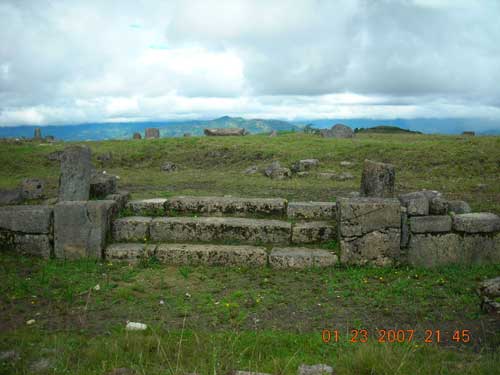Pacopampa on:
[Wikipedia]
[Google]
[Amazon]
 Pacopampa ( qu, paqu pampa) is an archaeological site located in the northern highlands of Peru, in the department of
Pacopampa ( qu, paqu pampa) is an archaeological site located in the northern highlands of Peru, in the department of
 In the 1930s
In the 1930s
 Pacopampa ( qu, paqu pampa) is an archaeological site located in the northern highlands of Peru, in the department of
Pacopampa ( qu, paqu pampa) is an archaeological site located in the northern highlands of Peru, in the department of Cajamarca
Cajamarca (), also known by the Quechua name, ''Kashamarka'', is the capital and largest city of the Cajamarca Region as well as an important cultural and commercial center in the northern Andes. It is located in the northern highlands of Peru ...
. It presents the remains of a monumental ceremonial center, made with cut and polished stone. It belongs to the Formative period
Several chronologies in the archaeology of the Americas include a Formative Period or Formative stage etc. It is often sub-divided, for example into "Early", "Middle" and "Late" stages.
The Formative is the third of five stages defined by Gord ...
, dating from 1200 to 500 BC. The land where the reservoir extends belongs to the National University of San Marcos
The National University of San Marcos ( es, Universidad Nacional Mayor de San Marcos, link=no, UNMSM) is a public research university located in Lima, the capital of Peru. It is considered the most important, recognized and representative educ ...
, which through its ''Rural Andean History Seminar'' cares permanently for the monument.
Geographical location
It is within the village of Pacopampa at 2140 m in the Querocoto District of the province of Chota,Cajamarca Region
Cajamarca (; qu, Kashamarka; ay, Qajamarka) is a department and region in Peru. The capital is the city of Cajamarca. It is located in the north part of the country and shares a border with Ecuador. The city has an elevation of above sea le ...
. It is among the largest ceremonial centers of the northern highlands of Peru. At its surroundings a dozen of archaeological sites have been identified, which a couple have been studied. These are called Chapel and El Mirador, located one kilometer east. Further, 3 km southeast, is Pandanche another Formative period ceremonial center.
Research
 In the 1930s
In the 1930s Rafael Larco Hoyle
Rafael Larco Hoyle (18 May 1901 in Chicama Valley, Peru – 23 October 1966, Lima), raised at Chiclin, his family's estate, was sent to school in Maryland, United States, at the age of twelve. He later entered Cornell University to study agric ...
visited the area where samples were collected from the lithosculpture that then he brought it to his museum in Chiclín (Trujillo) and today it is found in the Larco Museum
The Larco Museum (officially known as Rafael Larco Herrera Archaeological Museum, in es, Museo Arqueológico Rafael Larco Herrera, links=no) is a privately owned museum of pre-Columbian art, located in the Pueblo Libre District of Lima, Peru. The ...
in Lima. He was the first to report, though brief manner on such findings on the site. Pacopampa was related to the Chavin culture
Chavin may refer to:
Places
* Chavín de Huantar, an archaeological site in Peru built by the Chavín culture
* Chavín District, Chincha, Peru
* Chavín de Huantar District, Huari, Peru
* Chavín de Pariarca District, Huamalies, Peru
* Chavin, I ...
when Tello made his theory about the origin of the Peruvian.
In 1966, Pablo Macera traveled to the archaeological site and investigated. Anxious to protect it, in 1970 succeeded Dr. Emilio Choy made a donation to the University of San Marcos so that it could acquire the land so that the excavations would start. Since then and through the Rural Andean History Seminar, the university has consistently care for the monument.
Hermilio Roses and Ruth Shady
Ruth Martha Shady Solís (born December 29, 1946, Callao, Perú) is a Peruvian anthropologist and archaeologist. She is the founder and director of the archaeological project at Caral.
Career
Throughout her career, she has directed many diffe ...
explored the architectural structure and conducted excavations (1970). By analyzing pottery they differed a stage prior to the Chavin influence Pacopampa-called Pacopampa (1200 BC), different from the one that follows, entitled Pacopampa-Chavin (700 BC).
The Lady of Pacopampa
In 2009 a team of archaeologists of the Pacopampa Archaeological Project, directed by Yuji Seki, announced the discovery of the tomb of a woman, presumably a person of great power in the area, from around 900 BC or so. The tomb, shaped like a boot, is very deep and had been in all that time free from looters or grave robbers. The woman, now named "The Lady of Pacopampa" measured 155 cm and when she died she must've been between 30 and 40 years of age. She had an artificially deformed skull and she was buried with rich grave goods composed by earmuffs, gold earrings, ceramic pots and seashell necklaces. It was also found that her skull was dipped incinnabar
Cinnabar (), or cinnabarite (), from the grc, κιννάβαρι (), is the bright scarlet to brick-red form of mercury(II) sulfide (HgS). It is the most common source ore for refining elemental mercury and is the historic source for the bri ...
. There are indications that she was buried before the construction of the ceremonial temple.
References
{{Archaeological sites in Peru Archaeological sites in Peru Archaeological sites in Cajamarca Region Chavin culture National University of San Marcos Cultural heritage of Peru